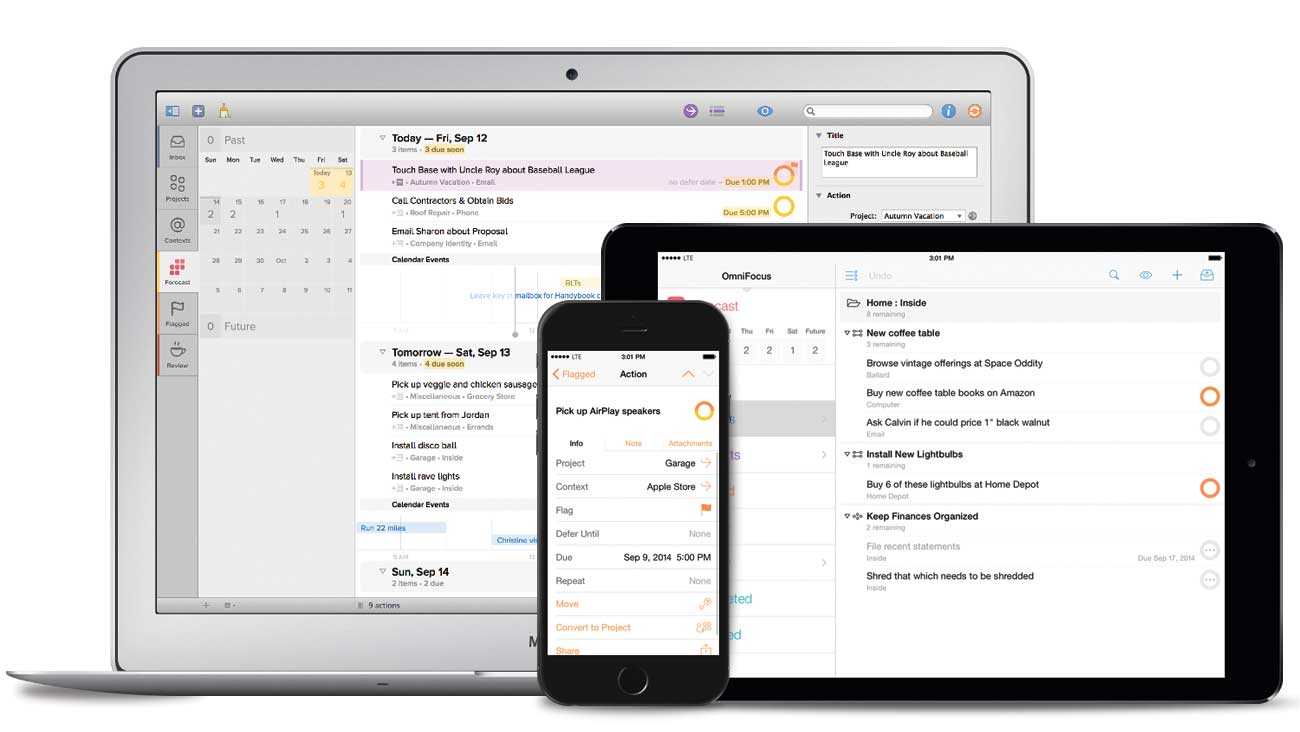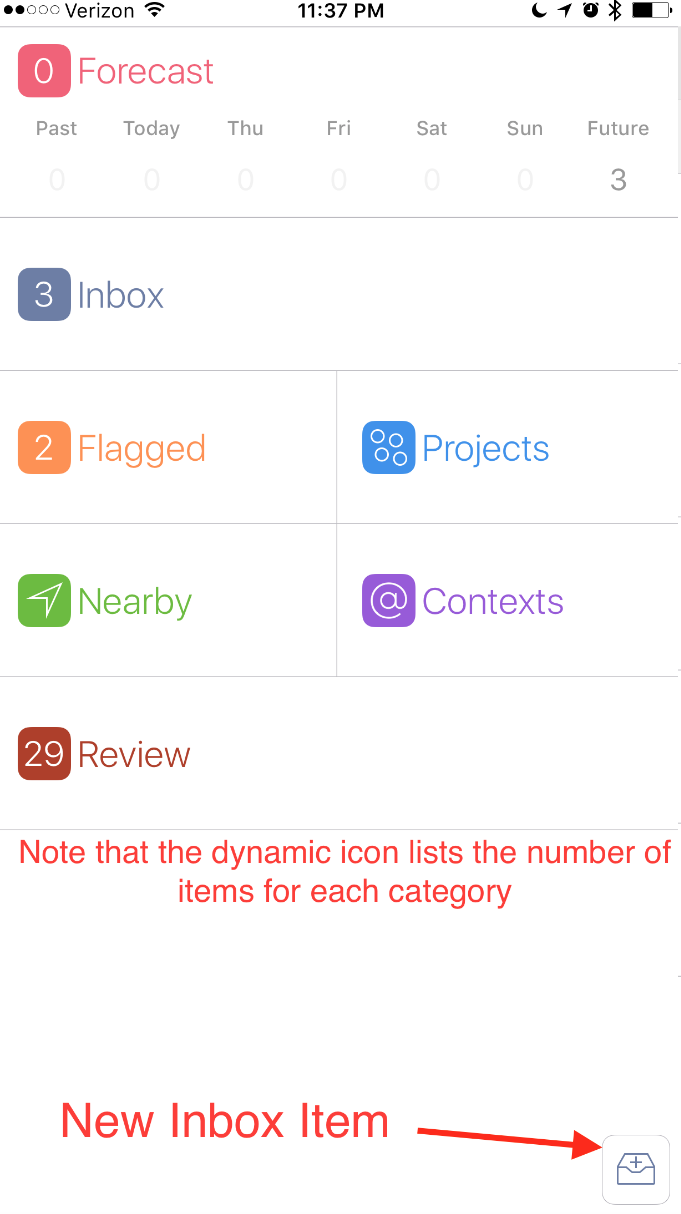Adobe ppd download mac. GitHub - zdong1995/OmniFocus-Tyme-Script: Automation scripts for OmniFocus and Tyme to boost GTD productivity and time management.
With versions available for both iOS and OS X, OmniFocus is the most powerful task management system intended for individuals on the Apple platform. OmniFocus is highly configurable, allowing the user to tailor it to their own particular approach to GTD (Getting Things Done). Until recently, I’ve struggled with identifying an ideal approach to using OmniFocus for task management. The solution I settled on is described in this post.
The core GTD principles

The first principle of GTD is capture—i.e. getting things out of your head and into a place you can rely on to keep them safe while they wait for later processing. This principle applies equally to everyone.
A second principle of GTD is the separation of tasks by context, and it is here where much of the discussion regarding various approaches to GTD is (rightfully) focused. Some people contextualize their tasks around physical energy levels (high, low), some around where tasks can be done (home, office, computer, on the phone) and some around task nature (work, personal, errands). I’ve experimented with all of these, and ultimately they all fell short.
My task management objectives
- The Basics of GTD in OmniFocus Getting Things Done, or GTD, is a popular productivity methodology imagined and realized by David Allen. GTD is a way to manage everything from your day to day stu! To those dreams you don’t yet know how to accomplish. This manual intends to explore the im.
- GTD and the Power of Defer in OmniFocus by Jason Atwood A look at how to combine four different GTD® principles into a practice using OmniFocus and the power of deferring. One of the many things I love about OmniFocus is that it can take your GTD practice to a new level, bringing core concepts into simple features.
- OmniFocus (Mac / iOS): as our previous “power user” recommendation, the most powerful of all the GTD-esque Mac apps is at the top of our list. It continues to offer the highest level of customization and power features that many people find essential for their workflows.
- There is an OmniFocus Web version that will allow you to access and work with your tasks from any device. This can be really handy if you want to use OmniFocus, but can’t install it on your work device. For more information on how we recommend using OmniFocus with GTD, check out this OmniFocus GTD podcast episode we did for The Productivity Show.
The problem starts with capture. Since the objective of capture is keeping your head clear, the process results in my inbox containing two types of tasks—those I will do, and those I might do.
Of course there are other dimensions in which you could classify those tasks, but over time, I’ve discovered that the effective separation of these two has the most impact, for me, in making GTD actually work.


The challenge then has been identifying a GTD approach that:
- Shows me what I will do, without cluttering that view with things I might do.
- Allows me at any time to see the things I might want to do, and within the context of a particular project.
- Ensures that I’m periodically reminded of the things I might want to do.
To achieve those objectives, here are the tools provided by OmniFocus which affect the visibility of tasks.
- Perspectives, OmniFocus’s configurable task views, determine task visibility primarily through the “Availability” settings—“Available” or “Remaining”. (Perspectives can also filter on due dates; but due dates aren’t really relevant to whether a task will or might get done, as usually a task with a due date is something that will get done.)
- A Project’s status can be set to “Active”, in which case its tasks will be visible in both “Available” and “Remaining” perspective filters, or “On Hold”, in which case its tasks will only be visible when filtered on “Remaining”.
- A Context’s status can also be set to “Active” or “On Hold”, with the same affect on visibility in perspective filters.
- A “Defer” date can be assigned to a task. If that date is in the future, then the task will only appear in the “Remaining” perspective filter, and not when filtered on “Available”.
Failed approaches
In the past, I tried to contextualize my tasks into “Work” and “Personal”, and then separate what I will and might do through the activity setting available to projects, e.g. Adobe spark download for mac. using an on-hold project called, “Someday/Maybe”. The problem with that approach was that that single project contained tasks relevant to a variety of other “real” projects, which made it difficult to achieve my second objective—allowing me to see what I might want to do—within the context of a particular project.
So I tried to address that problem by creating on-hold “Someday/Maybe” child projects within each of my real active projects. But as you can imagine, that became unwieldy and maintenance-heavy once the number of real projects grew to any sizable amount.
I also tried creating an on-hold context called “Someday/Maybe” as a child context within each of my “Personal” and “Work” contexts, but eventually came to realize even that resulted in too much confusion and complexity in both initial context assignment, and when needing to change a given task—or group of tasks—from things I might do to things I willdo.
I tried several other approaches as well and the result was always the same—either through over-complexity or incompatibility with my three objectives, OmniFocus wasn’t effectively helping me to get things done.
My solution
Realizing that in practice I didn’t actually view my tasks by “Work” and “Personal” contexts very often, even though I had organized them that way, I decided to try a simpler approach, consisting of only two contexts, the purpose of which is to answer the question, “Is this something I will do, or something I might do?”:
- “Active” (with status, Active)
- “Maybe” (with status, On Hold)
How To Use Omnifocus
Now, when processing, organizing and managing tasks, I ask myself only two questions:
- What project should this belong to? (Project assignment)
- Is this something I will do, or might do? (Context assignment)
Omnifocus Context
Here’s how that simplification fits into the core of my GTD approach.
Omnifocus Gtd
Weekly review process:
- Each Sunday, I use OmniFocus’s “Review” feature to review each of my projects. When reviewing a project, OmniFocus shows you all of its tasks, regardless of availability. This satisfies my third objective, i.e. making sure I’m periodically reminded of the tasks I might do.
- I may change the context of some tasks from “Maybe” to “Active”, if I’ve decided they will get done.
- I “flag” any “Active” task I want to work on during the following week.
- I’ll assign a future “Defer” date to any task that is “Active”, but which I know I won’t get to in the near future. For example, the task “Follow up with Steve”, if I know Steve is on vacation for the next two weeks. (This supports my first objective, seeing only those tasks which are currently relevant.)
Custom perspectives:
I have three core custom perspectives in OmniFocus which I access on a daily basis:
Omnifocus Gtd
- “Active”—shows flagged and due tasks. This is what I look at to determine what to work on, today. This supports my first objective, i.e. quickly seeing just those things I’ve decided I will work on.
- “Worklist”—shows all “available” tasks, grouped by project. This is my global list of stuff I’ve decided I will do, without the noise of what I might do, and therefore also supports my first objective.
- “Maybe”—that shows all “remaining” tasks, grouped by project. This supports my second objective, i.e. at any time being able to see the tasks I might want to do, in the context of their relevant projects.
This approach to GTD and OmniFocus has resulted, for me, in a task management approach that is powerful enough to meet my objectives while remaining simple and efficient enough that I actually follow it consistently—and results in the feeling that OmniFocus helps me to be more productive.
Annex: Perspectives

Someone in the comments asked to see details of how the custom Perspectives are defined. Here they are for OmniFocus 3:
